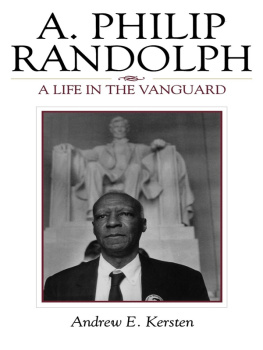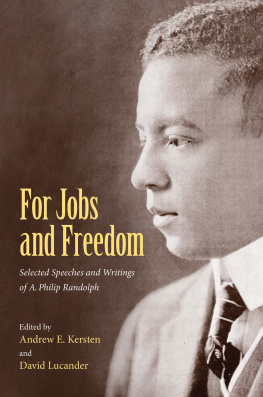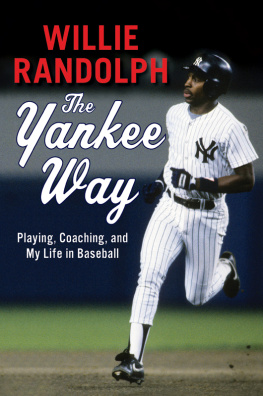REFRAMING RANDOLPH
CULTURE, LABOR, HISTORY SERIES
General Editors: Daniel Bender and Kimberley L. Phillips
The Forests Gave Way before Them: The Impact of African Workers on the Anglo-American World, 16501850
Frederick C. Knight
Unknown Class: Undercover Investigations of American Work and Poverty from the Progressive Era to the Present
Mark Pittenger
Steel Barrio: The Great Mexican Migration to South Chicago, 19151940
Michael D. Innis-Jimnez
Ordering Coal: Railroads, Miners, and Disorder in the Gilded Age, 18701900
Andrew B. Arnold
A Great Conspiracy against Our Race: Italian Immigrant Newspapers and the Construction of Whiteness in the Early Twentieth Century
Peter G. Vellon
Reframing Randolph: Labor, Black Freedom, and the Legacies of A. Philip Randolph
Edited by Andrew E. Kersten and Clarence Lang
Reframing Randolph
Labor, Black Freedom, and the Legacies of A. Philip Randolph
Edited by Andrew E. Kersten and Clarence Lang
NEW YORK UNIVERSITY PRESS
New York and London
NEW YORK UNIVERSITY PRESS
New York and London
www.nyupress.org
2015 by New York University
All rights reserved
References to Internet websites (URLs) were accurate at the time of writing. Neither the author nor New York University Press is responsible for URLs that may have expired or changed since the manuscript was prepared.
ISBN: 978-0-8147-8594-2 (hardback)
For Library of Congress Cataloging-in-Publication data, please contact the Library of Congress.
New York University Press books are printed on acid-free paper, and their binding materials are chosen for strength and durability. We strive to use environmentally responsible suppliers and materials to the greatest extent possible in publishing our books.
Manufactured in the United States of America
10 9 8 7 6 5 4 3 2 1
Also available as an ebook
This book is dedicated to my daughters, Bethany and Emily, and to my wife, Vickie.
Andrew E. Kersten, Moscow, Idaho
For Clarence Earl Lang, Sr. (19492013), who, seated behind the wheel of a Chicago Transit Authority bus, was a beneficiary of Randolphs many legacies.
Clarence Lang, Lawrence, Kansas
CONTENTS
Arlene Holt Baker
Andrew E. Kersten and Clarence Lang
Joe William Trotter, Jr.
Eric Arnesen
Cynthia Taylor
Robert Hawkins
Erik S. Gellman
Melinda Chateauvert
David Lucander
William P. Jones
Jerald Podair
FOREWORD
ARLENE HOLT BAKER
Reframing Randolph gives us a deeper understanding, appreciation, respect, and much needed critical analyses of the complexities of A. Phillip Randolph, who, through his oratory, his written words, and his organizing and mobilizing skills, was able to improve the working conditions and economic lives of African Americans and move Americas social and civil rights landscape closer to the promise of equality for all.
These roads were sometimes straight, sometimes rocky, and sometimes narrow, but all of them led to the improvement of self, the improvement of the human condition, and the improvement of the working conditions for black workers in general and the Pullman Porters in particular. These roads also led Randolph to his long envisioned plan of a march for freedom on the nations capital. In reflecting on his role in the labor and civil rights movements as researched and analyzed by the historians who contributed to this book, I am reminded of the importance of Randolph in those movements and how his labors and legacy indirectly and directly touched my own life.
Growing up in Fort Worth, Texas, during the early 1950s and 1960s, I knew the world of Jim Crow and the suffering that many families and many in my neighborhood endured both emotionally and economically from those unjust laws of segregation and discrimination. I cannot recall Randolphs name ever being raised in the conversations that took place among my mother, my aunts, and from time to time a woman neighbor or two, but I will never forget the context of those conversations when it came to the discussion of what was considered a good job for a Negro man. The comparison was often made to the deceased husband of Mrs. Bunn, who lived across the street from us. In the womens words, Mr. Bunn was a man who ran the railroad, made a good living, plus tips, was well spoken, dignified, wore a uniform to work, and took care of his family. Of course, I would come to the knowledge, as I grew older, that Mrs. Bunns husband was a Pullman Porter. Although Randolphs name was not mentioned, it was his ideals of black working-class manhood that formed the portrait of the black man who was well respected and revered in our home, our neighborhood, and our church. That was the image alive in the minds of Bible-rooted, hardworking domestics like my mother, who probably never saw themselves as union supporters. Yet their vision of a dignified Negro was A. Phillip Randolphs unionized Pullman Porters.
In August 1963, I was a month away from my thirteenth birthday, but I felt like I was coming of age. What I had seen on television and read over the prior months had pained, scared, and hardened me. The images of African Americans having dogs and fire hoses turned on them, school doors being blocked in the name of segregation now and segregation forever, and the knowledge that an assassins bullet had killed a young civil rights leader in Mississippiall had their impact, and I felt that a life with inequality was no real life at all.
I knew there were African Americans planning to go to Washington, D.C., to demand a change in our civil rights laws, and I thought the organizer and leader was Dr. Martin Luther King, Jr. Just as I did not know, as a young girl, of the significant role that A. Phillip Randolph played in making the 1963 March on Washington a historic reality, many todayparticularly the younger generation of African Americansare unaware of this significant piece of history. Reframing Randolph gives us a deeper understanding of the role that Randolph played in planning the 1963 March on Washington and with groups like the Negro American Labor Council (NALC), which was founded in 1960 to challenge segregation inside and outside the labor movement. This book also calls on us to reassess the roles that Randolph and the NALC played in pressuring Congress for the passage of our nations civil rights legislation and the laws that resulted in President Lyndon Johnsons War on Poverty.
Johnsons antipoverty legislation gave me my first opportunity to enter the workforce as a teenager in an after-school and summer jobs program. Working in the Corp of Engineers Acquisition Branch, I made more than the minimum wage and more than my mother made as a domestic. This opportunity helped me embark upon my own journey as an African American woman down the road of labor and social justice activism as a union organizer, and ultimately as the first African American to serve as the Executive Vice President of the American Federation of LaborCongress of Industrial Organizations (AFL-CIO), a position that I held from 2007 to 2013. I never had the opportunity to meet A. Phillip Randolph, but the role he played in advocating for and advancing the righteous cause of social and economic justice and his unwavering commitment to speak truth to power both within and outside the labor movement made my walk down the social justice road a lot easier. Daily I am reminded that the struggle to hold on to the social justice gains made by Randolph and others is neverending.








